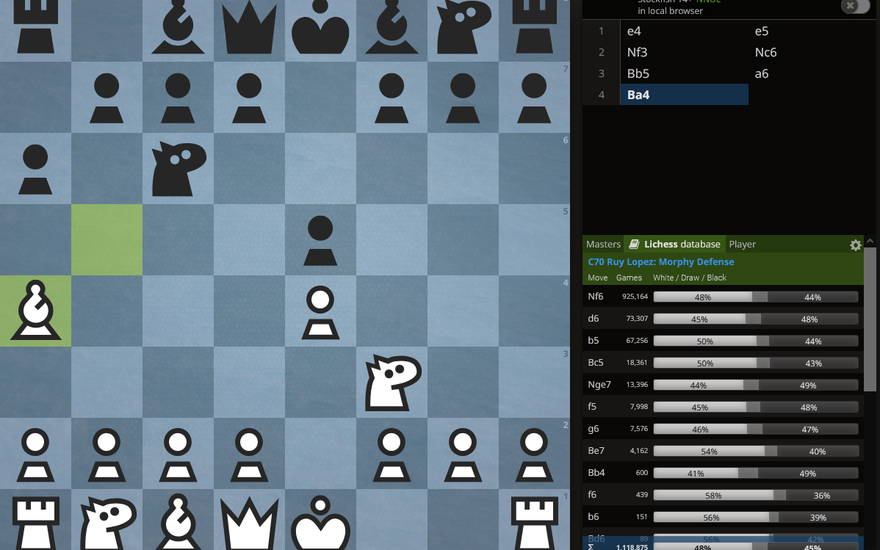
lichess screenshot
Prep - A Discussion
You don't need to prep as much as you think - here's why and how to prepIn online long time control chess leagues, such as Lichess4545 and Lonewolf (along with others) it is often a normal and expected part of the experience to prepare for your opponents. Many people claim that prep doesn’t really matter that much, but that angle has been argued about quite a lot already. More importantly, many people seem to have the impression that you need deep, hours-long preparation sessions before every game. This is in my opinion horribly false, and personally I’ve done quite respectably for myself with at maximum 10-15 minutes most weeks for preparation. This is partially due to how my approach to prep fits into my overall approach to opening study, which I think is also important.
The General Approach
How I started was to make a lichess study for each of white, black vs d4, and black vs e4. I then proceeded to build a repertoire file by putting in what I remembered off the top of my head + checking the lichess (both masters and regular) database to fill in the gaps/continue important lines. This works if you already have a rep, but what if you want to pick up a new opening? For instance, I picked up the Kan earlier this year. What I did for that was I (again based on the lichess database) basically looked at the major lines and extended them until I reached a middlegame I felt comfortable playing or the database started running very low on games- sometimes this was very early (some of the anti’s got to quite standard-looking IQP positions I felt like I should be able to play pretty early), sometimes this took quite a while (more forcing/main lines). If there was a notable possible deviation I would briefly cover it in a sideline.
While doing this process, you’ll quickly start to understand what generally you are trying to do in the opening and what setup(s) you’re trying to adopt. Additionally, I recommend quickly flipping through games in the master database to see what sort of plans and setups are often seen. If you’re confused by why a move isn’t played in a position, the easiest way to figure it out is to simply try it and check the engine (or database) for what the problem is. For instance, when I was building a study for the delayed steinitz, I was a bit confused by Black not playing the thematic pawn break f5 in the diagram, instead playing the seemingly pointless h6. I put f5 in and checked the engine’s recommendation and it suggested Ng5 and then Ne6, putting the knight on an oppressive outpost. This explains why f5 is bad (it allows this- if f5 wasn’t played just h6 would kick the knight back) and even why h6 is good (it prevents this idea). Further, I’ve understood a key motif, as this idea crops up quite a lot.
It’s somewhat harder to figure out why a move is played. Sometimes you can just have the other side play pointless waiting moves and see if there’s a threat - but this is sometimes not the right way to do it. Sometimes you can try other moves and see that there’s a hidden threat from the opponent or it’s preparing an idea.
A final good option for either of these cases is to simply ask a friend who plays this line - usually they’ll be able to provide a good reasoning for it.
Either way I strongly recommend you write the idea down in annotations for future you to reference later.
The most important part about this process is maintaining this study. After every game (blitz and longer) you should check what you played against your study and see who deviated first. If they deviated first and you think it’s an important enough line to briefly cover, then you can cover an appropriate reaction. This serves as a good way to review and remember lines, with more common lines being reviewed more. This in my opinion is a much better way to do spaced repetition than a chessable-type approach.
I also would recommend adding annotations for if a local player in your OTB scene plays a line in the study, to make it easier to review before a game with them. This is very much optional but I think it’s worthwhile.
An example of a study I did this process with is https://lichess.org/study/wKyoRGQR. I should have put far more annotations, but other than that I think it’s a pretty good example of how to do this.
How To Select Lines Using The Lichess Database
I mentioned earlier that I use the lichess database religiously to help me in selecting lines. You might think this just means choosing the top line at every point, but I instead look for lines that score well (and of course, are sane and aren’t like immediately messed up by a refutation - I have some standards!). For instance, the delayed steinitz (d6 in the diagram) scores noticeably better for black than the other options, which was a major reason why I decided to play it for a while.
An important detail to note is that you should set your filters according to your rating - I typically use 2200+ Blitz/Rapid/Classical as my filters. In my opinion, you should round your (blitz) rating down to the nearest setting and filter to that and above. I would use all of blitz rapid and classical as blitz is still a slow enough time control to allow for good data while increasing the sample size greatly. I don’t use bullet or correspondence because bullet is probably too fast and correspondence is just generally really weird.
It is worth being wary of this and it’s far from perfect (e.g. Nh3 d5 Rg1 has an insane score for white on some filters, because of one player spamming it versus lower rated’s in bullet), but it is usually accurate.
It is also worth noting that it is often a good idea to ask friends or consult resources to help choose your lines - this is perhaps the easiest way to get good lines you know you can trust in.
What Do I Do To Prepare?
When I’m paired versus a new opponent, I quickly check what they play (using the lichess player opening explorer), and go to the requisite study - for instance the week I wrote this I was playing vs my friend nerja25390. I found the line he plays in my study (as a sidevariation in the chapter I set apart for various anti-sicilians), and was prepared for it. I had already figured out my line and I was done after a brief look.
This is effectively what I do for every single week, I briefly check what they play vs my studies and review the appropriate passages.
The only time I really have to put work in is if they play into a line I’ve been unhappy with or haven’t covered yet. In these cases, I might decide to change things or add the line. This is something I probably should do at some point, so this is merely a way to spur me on to handle this hole. I then follow the same process as I do when originally building the repertoire.
It gives me a lot of security to have a convenient way to quickly check what I play versus any line, instead of trying to half remember and reinvent the wheel every single week.
Hopefully this helps you build your own repertoire file and prepare for your games, or at least gives you some ideas. Good luck & have a great rest of your day! I'm hoping to write more articles like this on my blog & generally help other players improve and learn.

